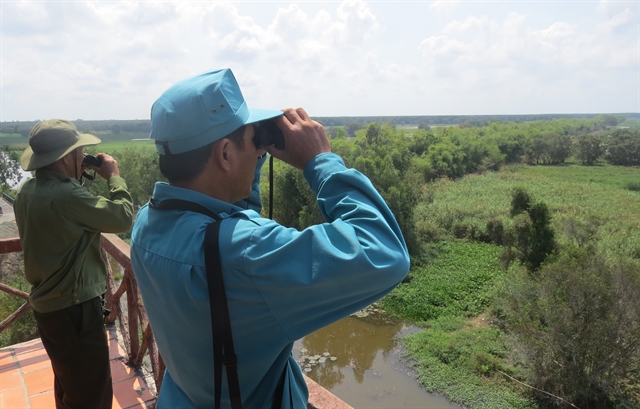 Society
Society

The Tràm Chim National Park in Đồng Tháp Province has 13 bird species that face the danger of extinction and need protection, according to park authorities.

|
| Rangers at the Tràm Chim National Park in Đồng Tháp Province keep watch from a tower. – VNA/VNS Photo Chương Đài |
ĐỒNG THÁP — The Tràm Chim National Park in the Mekong Delta Province of Đồng Tháp has 13 bird species that are facing the danger of extinction and need urgent protection, according to park authorities.
They include the red-headed crane, yellow – breasted bunting, common kestrel, eastern grass owl, eastern marsh – harrier, spot billed pelican, painted storks, and white-rumped shama.
According to a survey, 42 per cent of the birds live in freshwater swamp, 10 per cent in grasslands, others make use of the riparian forest areas, channels, bush or mixed habitats.
The park, which spreads over more than 7,300ha in Tam Nông District and has mostly cajuput trees, is a Ramsar wetlands site of international importance.
It also has 101 other bird species, and among the country’s major bird sanctuaries.
The park’s cỏ năng kim (Eleocharis ochrostachys) and cỏ năng ống (Eleocharis dulcis) habitats provide food to its iconic birds like red-headed cranes and painted storks.
The former typically grow up to 1.8m and are the world’s tallest flying bird.
The park’s lotus, wild rice, cajuput, and other plant growing areas provide habitats for the birds to nest and roost.
Nguyễn Thế Hanh, deputy director of the park, said the park is well protected, especially against forest fires in the dry season.
Hunters are not allowed in the park.
Its water resources are carefully regulated to protect the environment, he said.
It regularly carries out activities to conserve birds like doing surveys of them, protecting red-headed cranes, protecting habitats, and providing food during the reproductive season, he added.
The park has renovated 22 areas to provide food for birds that have attracted 16 species that live there now, and also provided food in a reproduction area located in its A2 Zone.
But the number of birds in the latter area has been falling every year because of a decline in the density of cajuput forests and food sources, illegal entry by people into the bird reproduction area, and bad weather.
The number of red-headed cranes returning to the park has reduced consistently since 2015 because of various reasons including a decline in food availability.
The habitats of cỏ năng kim, which are the main prey for red-headed cranes shrank from 190ha in 2015 to 80ha last year.
In the event, only 11 red-headed cranes came to the park last year.– VNS




